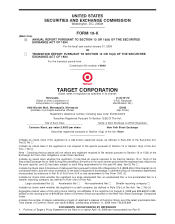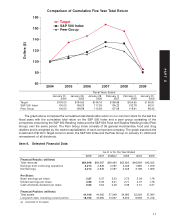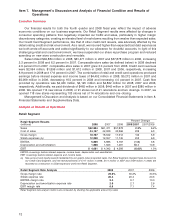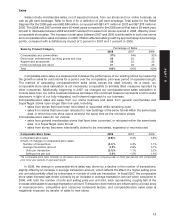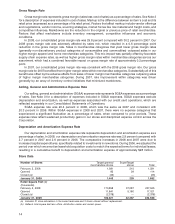Target 2008 Annual Report Download - page 24
Download and view the complete annual report
Please find page 24 of the 2008 Target annual report below. You can navigate through the pages in the report by either clicking on the pages listed below, or by using the keyword search tool below to find specific information within the annual report.Geographic Information
Substantially all of our revenues are generated in, and long-lived assets are located in, the United States.
Available Information
Our Annual Report on Form 10-K, quarterly reports on Form 10-Q, current reports on Form 8-K and
amendments to those reports filed or furnished pursuant to Section 13(a) or 15(d) of the Exchange Act are
available free of charge at www.Target.com (click on ‘‘Investors’’ and ‘‘SEC Filings’’) as soon as reasonably
practicable after we file such material with, or furnish it to, the Securities and Exchange Commission (SEC).
Our Corporate Governance Guidelines, Business Conduct Guide, Corporate Responsibility Report and the
position descriptions for our Board of Directors and Board committees are also available free of charge in print
upon request or at www.Target.com (click on ‘‘Investors’’ and ‘‘Corporate Governance’’).
Item 1A. Risk Factors
Our business is subject to a variety of risks. The most important of these is our ability to remain relevant to
our guests and a brand they trust. Meeting our guests’ expectations requires us to manage various
operational and financial risks. Set forth below are the most significant risks that we face.
Our success depends on our ability to positively differentiate ourselves from other retailers.
The retail business is highly competitive. In the past we have been able to compete successfully by
differentiating our shopping experience by creating an attractive value proposition through a careful
combination of price, merchandise assortment, convenience, guest service and marketing efforts. Guest
perceptions regarding the cleanliness and safety of our stores and our in-stock levels are also factors in our
ability to compete. No single competitive factor is dominant, and actions by our competitors on any of these
factors could have an adverse effect on our sales, gross margin and expenses. If we fail to continue to
positively differentiate ourselves from our competitors, our results of operations could be adversely affected.
If we fail to anticipate and respond quickly to changing consumer preferences, our sales, gross margin
and profitability could suffer.
A substantial part of our business is dependent on our ability to make trend-right decisions in apparel,
home d´
ecor, seasonal offerings and other merchandise. Failure to accurately predict constantly changing
consumer tastes, preferences, spending patterns and other lifestyle decisions could lead to lost sales,
increased markdowns on inventory and adversely affect our results of operations.
All of our stores are located within the United States, making us highly susceptible to deteriorations in
U.S. macroeconomic conditions and consumer confidence.
All of our stores are located within the United States, making our results highly dependent on U.S.
consumer confidence and the health of the U.S. economy. In addition, a significant portion of our total sales is
derived from stores located in five states: California, Texas, Florida, Minnesota and Illinois, resulting in further
dependence on local economic conditions in these states. The success of our credit card business is also
highly dependent on consumers’ willingness to use credit cards over other payment methods, their ability to
pay and our ability to anticipate changes to the risk profile of our cardholders when extending credit.
Deterioration in macroeconomic conditions and consumer confidence could negatively impact our business
in many ways, including:
• Slowing sales growth or reduction in overall sales.
• Reducing gross margins.
• Increasing our expenses, including bad debt expense.
4







